
WILPATTU NATIONAL PARK
Located on the North-Western coast of the country, Wilpattu is the largest National Park in the island. It covers an area of 131,693 hectares of dry lowland forest with a unique cluster of water bodies referred to as “Villus” which are naturally formed rain fed lakes. It is said that these villus are also fed by ground water sources and the creation of the villu is due to such ground water reaching the surface of the earth due to pressure created underground. The area was declared a sanctuary in 1905 and was upgraded as a national park on the 25th of February 1938. Wilpattu North Sanctuary declared on 7th November 1947, lies inland from the coast, is contiguous with the park and is located entirely within the Northern Province.
The clusters of Villus or lakes found in the park are flat basin like depressions. Two of these, Lunu Wila and Kokkare Wila are saline. The altitude of the park is more or less even and ranges from sea level to only 152ft at the highest point. While the areas of the park bordering the sea are covered primarily with low scrub and salt grass, 73% of the park is covered in dense forest or scrub and the rest is more open habitat.
LOCATION
The park is 182km from colombo and can be reached by taking the A3 Highway from Colombo to Puttalam and proceeding 42km thereafter on the A12, Puttalam- Anuradapura Highway until you reach the large signboard and turn off to the left. This 8km road takes you to the park office located at Hunuwilagama.
SPECIES DIVERSITY
Mammals
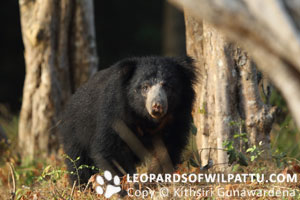 Wilpattu is an excellent park to observe many species of mammals including the top predator of the country the Sri Lankan Leopard Panthera pardus kotiya. Even though early mornings and late evenings are the best times to observe them, I have had many sightings of leopards during different times of the day including midday.
Wilpattu is an excellent park to observe many species of mammals including the top predator of the country the Sri Lankan Leopard Panthera pardus kotiya. Even though early mornings and late evenings are the best times to observe them, I have had many sightings of leopards during different times of the day including midday.
Many other species of mammals can also be observed here which include the Sloth Bear Melursus ursinus, Golden Jackal Canis aureus, Sambar Cervus unicolor, Spotted Deer or Chital Axis axis, Barking Deer or Red Muntjac Muntiacus muntjac malabaricus, Indian Gerbil Tatera indica, Grey Langur Semnopithecus priam and the Ruddy Mongoose Herpestes smithii.
A number of mammal species, which are endemic to the island, also can be met with at Wilpattu and they include the Golden Palm Civet Paradoxurus zeylonensis, Northern Mouse Deer or White-spotted Chevrotain Moschiola meminna as well as the north central dry zone subspecies of the endemic Purple-faced Leaf Monkey Semnopithecus vetulus philbricki.
Wilpattu has always been less famed for the sighting of the Asian Elephant Elephas maximus. Even though gatherings of 40-50 animals as well as majestic tuskers have sometimes been recorded in the park during the dry season from July to September, during most of the year the elephants are generally known to frequent the less visited western side of the park including Pomparrippu. However lone bull elephants can be seen throughout the year feeding on the vegetation at the main cluster of frequently visited Villus and herds are generally seen only during the height of the dry season.
Birds
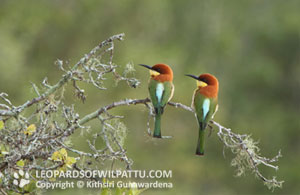 Wilpattu is also a paradise for resident as well as migrant species of birds. The commonly seen migrants includes the Indian Paradise Flycatcher Terpsiphone paradisi paradisi, Asiatic Golden Plover Pluvialis fulva, Orange-headed Ground Thrush Zoothera citrina, Indian Pitta Pitta brachyura, Black-tailed Godwit Limosa limosa, Indian Blue Chat Luscinia brunnea and Pintail Snipe Gallinago stenura.
Wilpattu is also a paradise for resident as well as migrant species of birds. The commonly seen migrants includes the Indian Paradise Flycatcher Terpsiphone paradisi paradisi, Asiatic Golden Plover Pluvialis fulva, Orange-headed Ground Thrush Zoothera citrina, Indian Pitta Pitta brachyura, Black-tailed Godwit Limosa limosa, Indian Blue Chat Luscinia brunnea and Pintail Snipe Gallinago stenura.
The resident bird species include the lowland race babaulti of the endemic Brown-capped Babbler Pellorneum fuscocapillus, the dry zone race siccatus of the Black-fronted Babbler Rhopocichla atriceps, the race jerdoni of the Little Ringed Plover Charadrius dubius resident in the dry lowlands, the endemic Ceylon Grey Hornbill Ocyceros gingalensis, the Pompadour Green Pigeon Treron (pompadora)pompadora, Black-capped Bulbul Pycnonotus melanicterus , at least three colour forms of the Golden-backed Woodpecker Dinopium benghalense jaffnense, Racket-tailed Drongo Dicrurus paradiseus and the Forest Eagle-Owl Bubo nipalensis- a species commonly referred to as the “Devil Bird”.
The mixed breeding colony at the Maradanmaduwa Tank is used by many species of waterfowl including Spotted-billed Pelicans Pelecanus philippensis, White Ibis Threskiornis melanocephalus, Spoonbill Platalea leucorodia, Openbill Anastomus oscitans as well as Painted Stork Mycteria leucocephala. I once counted 23 Lesser Adjutant Leptoptilos javanicus, the highest number of this species that I had recorded in one locality in the country, at the Maradanmaduwa Tank during the height of the dry season in September 2012.
Reptiles
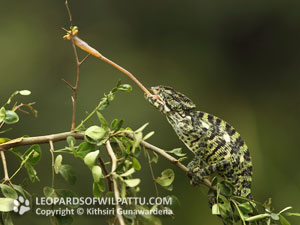 The most commonly seen reptile in the park is the Land Monitor Varanus bengalensis. However there are many species of interesting reptiles that inhabit the park including the Mugger Crocodile Crocodylus paluster, Star Tortoise Geochelone elegans, Softshell or Flapshell Turtle Lissemys punctata, both subspecies of the hard shell black turtles: Parker’s Black Turtle Melanochelys trijuga parkeri and Spotted Black Turtle Melanochelys trijuga thermalis and many species of snakes such as the Indian Cobra Naja naja, Indian Rat Snake Ptyas mucosa maximus, Indian Rock Python Python molurus molurus, Forsten’s Cat Snake Boiga forsteni, Common Bronze-back Dendrelaphis tristis, Indian Russell’s Viper Daboia russelii russelii, Common Bridal Snake Dryocalamus nympha, Flowery Wolf Snake Lycodon osmanhilli and the endemic Sri Lankan Flying Snake Chrysopelea taprobanica.
The most commonly seen reptile in the park is the Land Monitor Varanus bengalensis. However there are many species of interesting reptiles that inhabit the park including the Mugger Crocodile Crocodylus paluster, Star Tortoise Geochelone elegans, Softshell or Flapshell Turtle Lissemys punctata, both subspecies of the hard shell black turtles: Parker’s Black Turtle Melanochelys trijuga parkeri and Spotted Black Turtle Melanochelys trijuga thermalis and many species of snakes such as the Indian Cobra Naja naja, Indian Rat Snake Ptyas mucosa maximus, Indian Rock Python Python molurus molurus, Forsten’s Cat Snake Boiga forsteni, Common Bronze-back Dendrelaphis tristis, Indian Russell’s Viper Daboia russelii russelii, Common Bridal Snake Dryocalamus nympha, Flowery Wolf Snake Lycodon osmanhilli and the endemic Sri Lankan Flying Snake Chrysopelea taprobanica.
The Common Garden Lizard Calotes versicolor versicolor is the commonest agamid lizard seen in the park. The Green Garden Lizard Calotes calotes as well as the endemic Painted-lipped Lizard Calotes ceylonensis can be seen less frequently in the well-wooded areas. The ground dwelling endemic Lowland Kangaroo Lizard Otocryptis nigristigma can be seen among the leaf litter in tall forest areas of the park. The Fan-throated Lizard Sitana ponticeriana is mostly active during the midday heat in the sandy areas of the park.
Wilpattu is an important habitat where the rarely seen Sri Lankan Chameleon Chamaeleo zeylanicus occurs in good numbers.
Butterflies
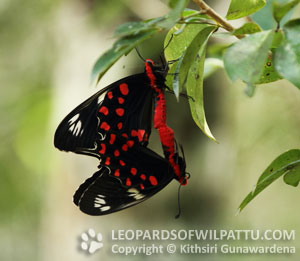 Wilpatttu offers many delights to the keen lepidopterist as well. Many species of butterflies can be observed in the park at the end of the rainy season. The white butterfly with a concave fore wing margin that is seen gathered in larg numbers close to puddles of water and which is preyed upon by all the Bee-eaters is the Lesser Albatross Appias paulina. The other more colourful species found in the park include the Blue Mormon Papilio polymnestor, Banded Peacock Papilio crino, Mime Chilasa clytia, Common Jay Graphium doson, Common Gull Cepora nerissa, Monkey Puzzle Rathinda amor, Great Orange Tip Hebomoia glaucippe, Blue Wanderer Pareronia ceylanica, Large Salmon Arab Colotis fausta, Great Eggfly Hypolimnas bolina, Red Spot Duke Dophla evelina, Indian Sunbeam Curetis thetis, Nawab Polyura athamas and the beautiful Tawny Raja Charaxes psaphon.
Wilpatttu offers many delights to the keen lepidopterist as well. Many species of butterflies can be observed in the park at the end of the rainy season. The white butterfly with a concave fore wing margin that is seen gathered in larg numbers close to puddles of water and which is preyed upon by all the Bee-eaters is the Lesser Albatross Appias paulina. The other more colourful species found in the park include the Blue Mormon Papilio polymnestor, Banded Peacock Papilio crino, Mime Chilasa clytia, Common Jay Graphium doson, Common Gull Cepora nerissa, Monkey Puzzle Rathinda amor, Great Orange Tip Hebomoia glaucippe, Blue Wanderer Pareronia ceylanica, Large Salmon Arab Colotis fausta, Great Eggfly Hypolimnas bolina, Red Spot Duke Dophla evelina, Indian Sunbeam Curetis thetis, Nawab Polyura athamas and the beautiful Tawny Raja Charaxes psaphon.
FLORA
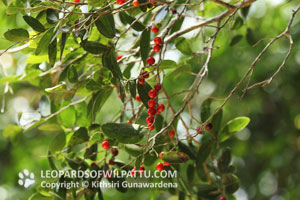 Dense forest and tall shrubs cover more than 70% of the park. The commonly seen tree and shrub species include Palu Manilkara hexandra, Weera Drypetes sepiaria, Ma-dan Syzygium cumini the fruits of which are favoured by the Sloth Bear, Burutha (Satinwood) Chloroxylon swietenia, Kaluwara (Ebony) Diospyros ebenum, Thimbiri Diospyros malabarica, Lunu Warna Crateva adansonii, Ila Pattha Maba buxifolia, Kora kaha (Blue Mist) Memecylon angustifolium, Radaliya Connarus monocarpus,Tammenna Mischodon zeylanicus as well as Kumbuk Terminalia arjuna that grows near the water bodies.
Dense forest and tall shrubs cover more than 70% of the park. The commonly seen tree and shrub species include Palu Manilkara hexandra, Weera Drypetes sepiaria, Ma-dan Syzygium cumini the fruits of which are favoured by the Sloth Bear, Burutha (Satinwood) Chloroxylon swietenia, Kaluwara (Ebony) Diospyros ebenum, Thimbiri Diospyros malabarica, Lunu Warna Crateva adansonii, Ila Pattha Maba buxifolia, Kora kaha (Blue Mist) Memecylon angustifolium, Radaliya Connarus monocarpus,Tammenna Mischodon zeylanicus as well as Kumbuk Terminalia arjuna that grows near the water bodies.
The park is also studded with a species of Cycas commonly referred to as Madu Cycas circinalis.
Wild Flowers
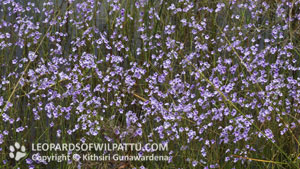 The picturesque endless carpets of small white bulbs seen on vast areas around most Villus is a species of Kok Mota Eriocaulon sp and the large patches of beautiful purple flowers are Bim Savan Dopatrium lobelioides. The other wild flowers seen in the park includes Wellangiriya Capparis zeylanica, Firecracker Flower Crossandra infundibuliformis, Andanahiriya Crotalaria laburnifolia, Ceylon Spider Lily Pancratium Zeylanicum, Pillila Dendrophthoe falcata, Niyangala Gloriosa superba, the endemic Bovitiya Osbeckia zeylanica, and the tiny purple flowers Heen Bim Savan Dopatrium nudicaule.
The picturesque endless carpets of small white bulbs seen on vast areas around most Villus is a species of Kok Mota Eriocaulon sp and the large patches of beautiful purple flowers are Bim Savan Dopatrium lobelioides. The other wild flowers seen in the park includes Wellangiriya Capparis zeylanica, Firecracker Flower Crossandra infundibuliformis, Andanahiriya Crotalaria laburnifolia, Ceylon Spider Lily Pancratium Zeylanicum, Pillila Dendrophthoe falcata, Niyangala Gloriosa superba, the endemic Bovitiya Osbeckia zeylanica, and the tiny purple flowers Heen Bim Savan Dopatrium nudicaule.
Wild Orchids
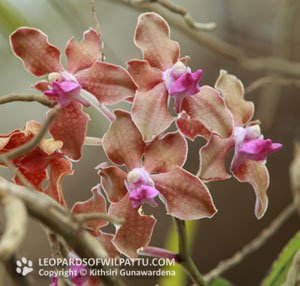 The beautiful Yellow flowers of the Vanda spathulata can be observed between September – January. The flower spikes grow straight up from the top most branches of tall bushes. The flowers of the more easily seen Vanda tessellata can also be found between September and January mostly on the trunks of the Palu trees. I have seen the purple as well as the rare pinkish red flowers of this species in the park. I also found the ground Orchid Habeneria plantaginea referred to as “Narilatha” in bloom at two locations of the park. The spectacular white flowers of the leaf less orchid Vannilla walkarae can also be observed at many localities including Maradanmaduwa, Borupan Wila, Kumbuk wila as well as Thimbiri Wila between May and June.
The beautiful Yellow flowers of the Vanda spathulata can be observed between September – January. The flower spikes grow straight up from the top most branches of tall bushes. The flowers of the more easily seen Vanda tessellata can also be found between September and January mostly on the trunks of the Palu trees. I have seen the purple as well as the rare pinkish red flowers of this species in the park. I also found the ground Orchid Habeneria plantaginea referred to as “Narilatha” in bloom at two locations of the park. The spectacular white flowers of the leaf less orchid Vannilla walkarae can also be observed at many localities including Maradanmaduwa, Borupan Wila, Kumbuk wila as well as Thimbiri Wila between May and June.
In this note I have only mentioned a few of the fauna and flora that I have been able to observe during my field trips to Wilpattu National Park as an introduction. Comprehensive lists of species that I have observed so far in the park are included in this site and will be updated periodically when new species are observed.
Locations in Wilpattu National Park
- Aalam Villu
- Aliwadiya
- Amadar Villu
- Andachchi Mottai
- Andachchi Mottai
- Atambagaha Uraniya
- Aththa Wila
- Avatara Mottai
- Boradiya Wala
- Boralu Wala
- Borupan Wila
- Cheena Uttu
- Dangaha Uraniya
- Dangaha Wewa
- Demata Wila
- Eluwankulama
- Erenapala Mottai
- Eriyakulam Pooval
- Gal Wala
- Galbendinirawiya
- Galge Viharaya
- Horun Bindapu Wewa
- Humbas Wala
- Hunuwilagama
- Ibba Wala
- Ikirigolla wewa
- Illanda Mottai
- Kalagedi Bokkuwa
- Kali Villu
- Kandegamuwa
- Kanjuran Villu
- Karambakulama
- Karanchiuttan
- Karawalakuda
- Katarampu Villu
- Kaya Mottai
- Kikiliya Villu
- Kimbulaketugala
- Kohomba wala
- Kok Motte
- Kokkare Villu
- Kolinji Wila
- Kollankanatte
- Kombansanchi Pooval
- Koonvetiyagala Ruins
- Kuda Andaragollewa Wewa
- Kuda Boralu Wala
- Kudapatessa
- Kudawilachchiya Wewa
- Kuduremale
- Kukulkatuwa
- Kumbuk Wila
- Kumula Villu
- Kumutu Villu
- Kuruttupandi Villu
- Lunu Wila
- Madan Gaha Wala
- Maduru Odai
- Maha Andaragollewa Wewa
- Maha Wewa
- Mahapatessa
- Maila Villu
- Maila Wala
- Maila Wewa
- Mailangan Motte
- Makalanmaduwa
- Makulu Ganga Uraniya
- Mallimadu
- Mana Wila
- Manikkapola Uttu
- Manikrala Uraniya
- Maradanmaduwa
- Marai Villu
- Marikaram Villu
- Menikrala Uraniya
- Modaneliya
- Moolakandavali
- Mootakal Aththi Mottai
- Moragollawa
- Mullikulam
- Naduna Wila
- Namada Wila
- Nawaladi Uttu
- Nelum Wila
- Ochchappu Kallu
- Pacchaodei
- Pala Mottai
- Pallekandal Wewa
- Palugahature
- Palukola Wala
- Panikkar Villu
- Park Entrance
- Pattieliya
- Paya Mottai
- Peddiveli Wewa
- Percy Bendi Wewa
- Periya Naga Villu
- Periya Uppu Villu
- Pillmotte
- Pomparippu
- Sad Suda Kallu
- Sengapadu Wila
- Sinna Marai Villu
- Sinna Uppu Villu
- Siyambalaatte Wala
- Sudu Muwa Wala
- Tala Wila
- Thambi Oluwa
- Thammanna Wala
- Thanga Villu
- Thekkama
- Thelambugas Wala
- Thelbeepu Wewa
- Thimbiri Wila
- Thora Wila
- Udappu Wila
- Vilanda Wala
- Walas Wala
- Wattathaluwa
- Weerakutti Villu
- Weli Ela
- Welvetiya Wala